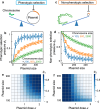The evolutionary landscape of prokaryotic chromosome/plasmid balance
- PMID: 39496780
- PMCID: PMC11535066
- DOI: 10.1038/s42003-024-07167-5
The evolutionary landscape of prokaryotic chromosome/plasmid balance
Abstract
The balance between chromosomal and plasmid DNAs determines the genomic plasticity of prokaryotes. Natural selections, acting on the level of organisms or plasmids, shape the abundances of plasmid DNAs in prokaryotic genomes. Despite the importance of plasmids in health and engineering, there have been rare systematic attempts to quantitatively model and predict the determinants underlying the strength of different selection forces. Here, we develop a metabolic flux model that describes the intracellular resource competition between chromosomal and plasmid-encoded reactions. By coarse graining, this model predicts a landscape of natural selections on chromosome/plasmid balance, which is featured by the tradeoff between phenotypic and non-phenotypic selection pressures. This landscape is further validated by the observed pattern of plasmid distributions in the vast collection of prokaryotic genomes retrieved from the NCBI database. Our results establish a universal paradigm to understand the prokaryotic chromosome/plasmid interplay and provide insights into the evolutionary origin of plasmid diversity.
© 2024. The Author(s).
Conflict of interest statement
The authors declare no competing interests.
Figures




Similar articles
-
Plasmid and chromosome segregation in prokaryotes.Trends Microbiol. 2000 Jul;8(7):313-20. doi: 10.1016/s0966-842x(00)01787-x. Trends Microbiol. 2000. PMID: 10878766 Review.
-
Evolutionary Thrift: Mycobacteria Repurpose Plasmid Diversity during Adaptation of Type VII Secretion Systems.Genome Biol Evol. 2017 Mar 1;9(3):398-413. doi: 10.1093/gbe/evx001. Genome Biol Evol. 2017. PMID: 28391322 Free PMC article.
-
Evolutionary Trajectory of the Replication Mode of Bacterial Replicons.mBio. 2021 Jan 26;12(1):e02745-20. doi: 10.1128/mBio.02745-20. mBio. 2021. PMID: 33500342 Free PMC article.
-
The sequence of a 1.8-mb bacterial linear plasmid reveals a rich evolutionary reservoir of secondary metabolic pathways.Genome Biol Evol. 2010 Jul 12;2:212-24. doi: 10.1093/gbe/evq013. Genome Biol Evol. 2010. PMID: 20624727 Free PMC article.
-
Plasmid-chromosome cross-talks.Environ Microbiol. 2020 Feb;22(2):540-556. doi: 10.1111/1462-2920.14880. Epub 2019 Dec 11. Environ Microbiol. 2020. PMID: 31782608 Review.
Cited by
-
RNA-guided nucleases enable a gene drive of insertion sequences in plasmids.bioRxiv [Preprint]. 2025 Feb 21:2025.02.20.638934. doi: 10.1101/2025.02.20.638934. bioRxiv. 2025. PMID: 40027787 Free PMC article. Preprint.
-
Scaling laws of bacterial and archaeal plasmids.Nat Commun. 2025 Jul 2;16(1):6023. doi: 10.1038/s41467-025-61205-2. Nat Commun. 2025. PMID: 40603865 Free PMC article.
References
-
- Rodríguez-Beltrán, J., DelaFuente, J., Leon-Sampedro, R., MacLean, R. C. & San Millan, A. Beyond horizontal gene transfer: the role of plasmids in bacterial evolution. Nat. Rev. Microbiol.19, 347–359 (2021). - PubMed
-
- Carroll, A. C. & Wong, A. Plasmid persistence: costs, benefits, and the plasmid paradox. Can. J. Microbiol.64, 293–304 (2018). - PubMed
-
- Castañeda-Barba, S., Top, E. M. & Stalder, T. Plasmids, a molecular cornerstone of antimicrobial resistance in the One Health era. Nat. Rev. Microbiol.22, 18–32 (2023). - PubMed
MeSH terms
LinkOut - more resources
Full Text Sources

